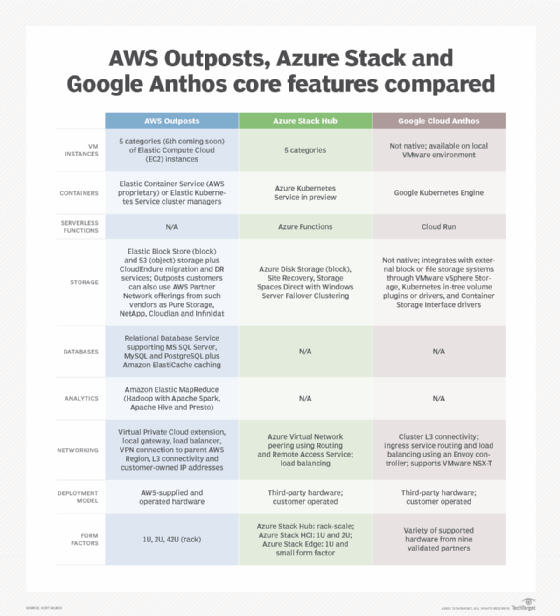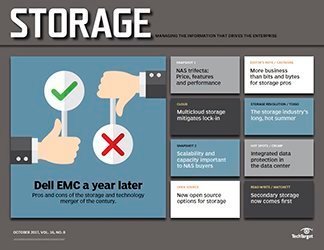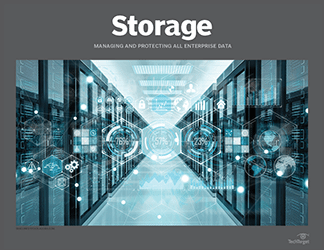Storage
- Editor's LetterSaaS data protection is a challenging but critical task
- Cover StoryExplore the consumption-based IT and Opex storage landscape
- InfographicData storage trends include increases in cloud, NAND flash
- FeatureAWS Outposts vs. Azure Stack vs. Google Anthos hybrid storage
- ColumnFive essential steps to build a cloud-native strategy
- ColumnStorage for edge computing is the next frontier for IoT

AWS Outposts vs. Azure Stack vs. Google Anthos hybrid storage
Explore the essential buy-in, deployment, implementation and management factors organizations should consider when comparing these major hybrid cloud storage services.
People hate making choices, so they'll usually opt for something that promises the best of both worlds. IT leaders and business executives are no different, which explains why most organizations have adopted hybrid cloud strategies that combine public cloud services and private infrastructure into a centrally managed, consistent cloud environment.
Until recently, the term hybrid cloud was so loosely defined that it applied to any organization using at least one public and one private cloud environment, regardless of whether they were connected or enabled workloads to seamlessly migrate from one to another. However, leading cloud providers have introduced integrated systems that enable cloud services previously only available on shared infrastructure to deploy on dedicated hardware in an organization's data center, branch offices or other facilities. Some of these, like VMware vCloud and Red Hat OpenShift, originated as private cloud software stacks that extended to shared service providers. Others, notably AWS Outposts, Microsoft Azure Stack and Google Anthos, started as public cloud services and adapted to enterprise hardware that can quickly deploy anywhere an organization needs dedicated cloud resources.
According to the "Flexera 2021 State of the Cloud Report," adoption of Azure Stack -- the oldest unified hybrid cloud system -- exceeds that of its primary cloud competitors, but AWS Outposts and Google Anthos are catching up fast. When the survey combined current, experimental and planned deployments, a scant 11 points separated the three.
The hybrid offerings from these three domestic hyperscale cloud providers are popular due to their tight integration of public and private infrastructure, consistent service APIs and centralized management interfaces. They're a better fit for enterprises looking to extend public cloud environments to on-premises locations than ad hoc hybrid cloud implementations built on different technology stacks.
This article summarizes the core features of AWS Outposts, Azure Stack and Google Anthos before focusing on the storage services each provides.
Core features
The table below summarizes the primary features of each product. Outposts has the largest selection of public cloud services, while Anthos focuses on container infrastructure that users can deploy on multiple platforms. Although Azure Stack Hub is similar to Outposts, Azure also offers down-scaled versions in Azure Stack HCI and Azure Stack Edge.
Storage services comparison
As the table below illustrates, the storage services vary widely. Here are the key elements for each product.
AWS Outposts provides the purest duplication of cloud-based storage services by offering local instantiations of Elastic Block Store (EBS) and Amazon S3 object storage. Outposts racks are pre-configured with a mix of Elastic Compute Cloud instance capacity and EBS storage volumes in a variety of configurations that span the following capacity tiers:
- EBS: 11 TB, 33 TB and 55 TB
- S3: 26 TB, 48 TB, 96 TB, 240 TB and 380 TB
Azure Stack Hub configurations include all-NVMe, a mix of NVMe and SSD or hybrid HDD-NVMe, or SSD. All-flash installations can be either single-tier or dual-tier (caching plus bulk storage). Storage Spaces Direct is versatile, scale-out, software-defined storage that supports three volume types:
- Infrastructure volumes host files using hosted VMs and Azure Stack core services.
- VM Temp volumes host temporary disks attached to tenant VMs.
- Object store volumes host tenant data servicing blobs, tables, queues and VM disks.
The Google Anthos platform does not provide native storage services, but instead relies on the underlying VM or bare-metal servers. For example, Anthos running on VMware would typically access a vSAN or similar scale-out software-defined storage to access block volumes, network file shares and object stores via Kubernetes container storage drivers. CSI drivers are also available for a variety of cloud and software-defined storage services.

Hardware deployment and equipment partners
Features aside, the three hybrid cloud platforms are quite different in how users purchase and manage them. Outposts is the most cloud-like in that the hardware is designed, produced, provided and managed only by AWS. Outposts creates a private AWS micro-region inside a customer's data center or branch office. Like other regions, AWS monitors the hardware and automatically applies software upgrades and patches. Outposts installations appear like any other region within the AWS management console.
Although on-premises Azure Stack and Anthos installations are also managed within their respective cloud management consoles, their purchasing, deployment and operational model is quite different from Outposts. Both Google and Microsoft partner with hardware companies like Cisco, Dell, HPE and Lenovo to provide integrated systems certified to work with their software stack. Customers get more flexibility in system configurations, price points and vendor support services using the partnership model. However, a significant amount of due diligence and planning is required. Azure Stack and Anthos also require customers to either manage the hardware or contract with a service provider for infrastructure installation and administration.
When evaluating these hybrid products, it's important to remember that they target different needs and audiences.
Outposts is best for heavy AWS users, particularly those who are reducing their data center footprint, but for performance or compliance reasons need to keep some data and applications on private infrastructure.
Azure Stack targets enterprises that have standardized on Microsoft system and application software and want to extend their Azure IaaS environments to locally installed and managed hardware.
Google Anthos appeals to organizations that have decided to make containers and the Kubernetes ecosystem the foundation of their enterprise applications and want container environments that can span multiple public and private clouds. Anthos also runs on AWS or Azure.
Related Resources
- How should our team manage data stored in the cloud? –TechTarget Cloud Computing
- 10 Cloud Storage Concepts to Master –TechTarget Storage
- Cloud Storage: Specific Use Cases and Ground Rules for Getting Started –TechTarget Storage
- 8 Deisions to Make Before Using Cloud Storage –TechTarget Storage



























